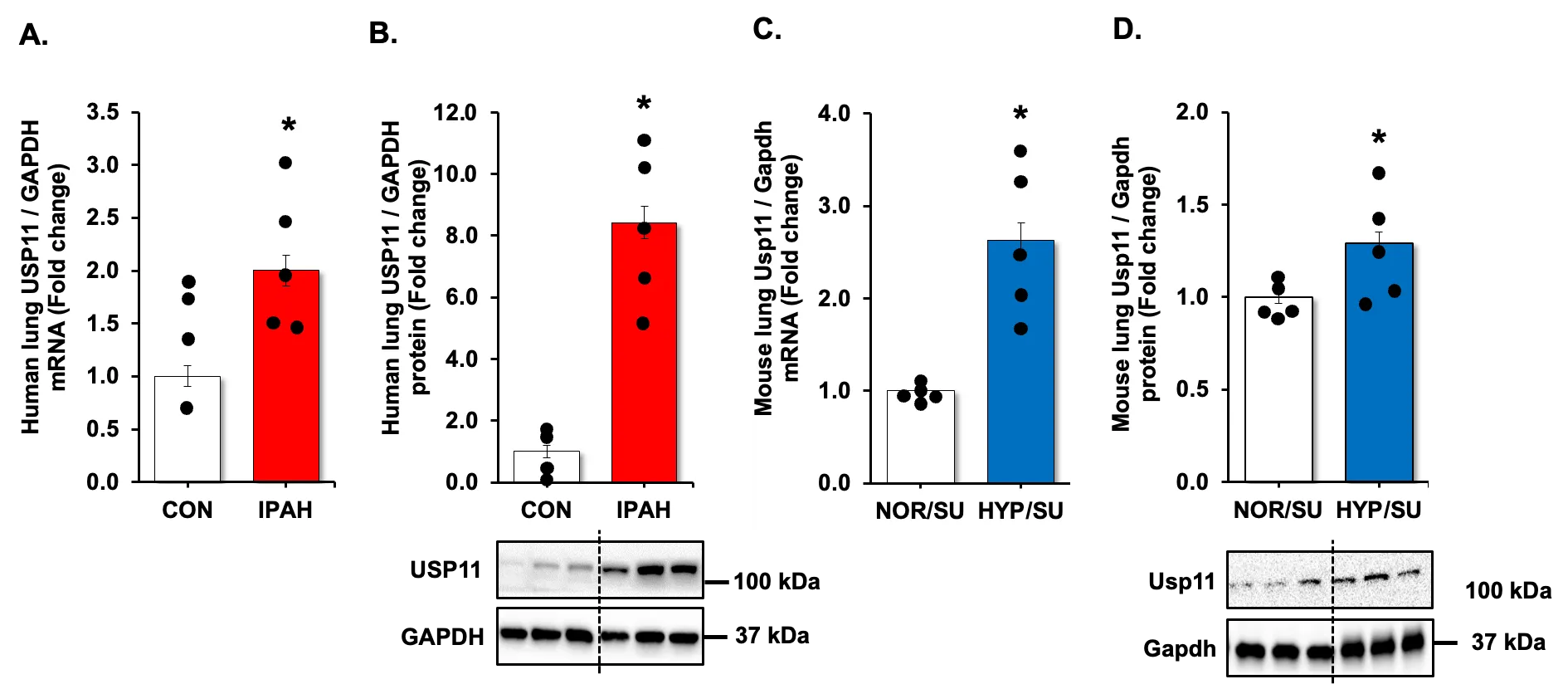Found 2 results
Open Access
Article
24 March 2025USP11 Promotes Endothelial Apoptosis-Resistance in Pulmonary Arterial Hypertension by Deubiquitinating HINT3
Pulmonary arterial hypertension (PAH) is a progressive, lethal, and incurable disease of the pulmonary vasculature. A previous genome-wide association study (GWAS) with Affymetrix microarray analysis data exhibited elevated histidine triad nucleotide-binding protein 3 (HINT3) in the lung samples of PAH compared to control subjects (failed donors, FD) and the positive correlations of HINT3 with deubiquitinase USP11 and B-cell lymphoma 2 (BCL2). In this study, we aim to investigate the roles and interplay of USP11 and HINT3 in the apoptosis resistance of PAH. The levels of USP11 and HINT3 were increased in the lungs of idiopathic PAH (IPAH) patients and Hypoxia/Sugen-treated mice. USP11 and HINT3 interacted physically, as shown by co-immunoprecipitation (co-IP) assay in human pulmonary arterial endothelial cells (HPAECs). HINT3 was degraded by polyubiquitination, which was reversed by USP11. Furthermore, HINT3 interacted with the anti-apoptotic mediator, BCL2. Overexpression of USP11 increased BCL2 content, congruent to elevated lung tissue levels seen in IPAH patients and Hypoxia/Sugen-treated mice. Conversely, the knockdown of HINT3 function led to a depletion of BCL2. Thus, we conclude that USP11 stabilizes HINT3 activation, which contributes to endothelial apoptosis-resistance of pulmonary arterial endothelial cells in PAH. This can potentially be a novel therapeutic target for ubiquitination modulators for PAH.

Open Access
Article
01 February 2024Molecular Regulation of Transforming Growth Factor-β1-induced Thioredoxin-interacting Protein Ubiquitination and Proteasomal Degradation in Lung Fibroblasts: Implication in Pulmonary Fibrosis
Thioredoxin-interacting protein (TXNIP) plays a critical role in regulation of cellular redox reactions and inflammatory responses by interacting with thioredoxin (TRX) or the inflammasome. The role of TXNIP in lung fibrosis and molecular regulation of its stability have not been well studied. Therefore, here we investigated the molecular regulation of TXNIP stability and its role in TGF-β1-mediated signaling in lung fibroblasts. TXNIP protein levels were significantly decreased in lung tissues from bleomycin-challenged mice. Overexpression of TXNIP attenuated transforming growth factor-β1 (TGF-β1)-induced phosphorylation of Smad2/3 and fibronectin expression in lung fibroblasts, suggesting that decrease in TXNIP may contribute to the pathogenesis of lung fibrosis. Further, we observed that TGF-β1 lowered TXNIP protein levels, while TXNIP mRNA levels were unaltered by TGF-β1 exposure. TGF-β1 induced TXNIP degradation via the ubiquitin-proteasome system. A serine residue mutant (TNXIP-S308A) was resistant to TGF-β1-induced degradation. Furthermore, downregulation of ubiquitin-specific protease-13 (USP13) promoted the TGF-β1-induced TXNIP ubiquitination and degradation. Mechanistic studies revealed that USP13 targeted and deubiquitinated TXNIP. The results of this study revealed that the decrease of TXNIP in lungs apparently contributes to the pathogenesis of pulmonary fibrosis and that USP13 can target TXNP for deubiquitination and regulate its stability.
